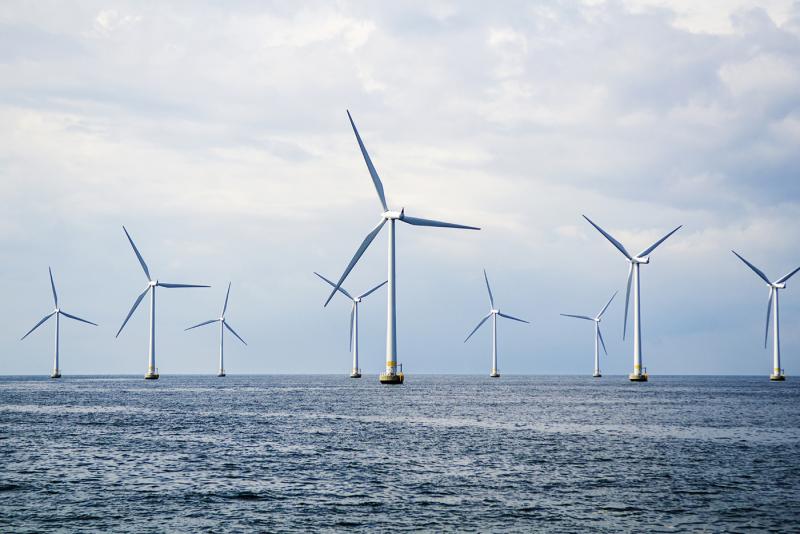A proposed wind farm in federally-regulated waters due east of Delaware’s coastline, which has seen no action since 2012, has been given a new lease on life. This time to the benefit of Maryland.
Introduced in 2008, Bluewater Wind, a 120-turbine, 200-megawatt-producing wind farm was touted as a job-producing, industry-leading venture for Delaware. In 2009, energy giant NRG bought Bluewater and then, in 2012, entered into a lease with the federal government to build the wind farm. But the inability to secure financing saw the project sink to the ocean floor before it even got a chance to swim.
Rhode Island-based Deepwater Wind bought the lease from NRG in 2016, and then submitted an application to Maryland’s Public Service Commission to develop the site. Deepwater built the country’s first wind farm off Block Island, Rhode Island. Those five turbines began transmitting energy May 1.
In a May 11 press release, the commission announced it had awarded offshore wind renewable energy credits to two projects.
The larger of the two projects, U.S. Wind Inc., is expected to be located 12 to 15 nautical miles due east off the coast of Ocean City, and is projected to include 62 turbines and produce 248 megawatts a year. The estimated construction cost is $1.375 billion, and it has a projected operation date of January 2020.
The second project, under the name Skipjack Offshore Energy, is the one located off Delaware’s coastline and operated by Deepwater. The commission approved a 15-turbine, 120-megawatt producing wind farm.
Maryland’s public utility regulator, based out of Baltimore, was given approval power by the state’s general assembly in 2013 with a piece of legislation called the Maryland Offshore Energy Act. The bill called for establishing an application and review process for proposed offshore wind projects to be conducted by the commission. It also said the sites had to be located on the outer continental shelf, between 10 and 30 miles off the Maryland coast, in an area that is designated for leasing by the Bureau of Ocean Energy Management within the U.S. Department of the Interior.
Clint Plummer, Deepwater vice president of development, said the Skipjack project will be located about 18 miles offshore. For comparison, a ferry ride from Lewes to Cape May is about 17 miles.
Plummer said the Skipjack project will take up about 15 square miles, or 20 percent, of the total leased area. He said the turbines are expected to be about a mile apart, but the final distance will be based on site-specific conditions. The estimated cost for the Skipjack project is $720 million, and it has a projected operation date of November 2022.
Plummer said the project’s transmission lines will feed into Delmarva Power’s energy grid. He said the exact connection location has yet to be determined, but the commission’s press release says Ocean City.
Benefits associated with construction and investments in infrastructure will be seen specifically in Maryland.
The commission says together the two projects have the potential to yield over $1.8 billion of spending in Maryland, spur the creation of almost 9,700 new direct and indirect jobs, and contribute $74 million in state tax revenues over 20 years.
As part of the award announcement, the Maryland commission attached nearly 30 conditions to the approval, including requirements that the developers create a minimum of 4,977 direct jobs during the development, construction and operating phases of the projects; pass 80 percent of any construction costs savings to ratepayers; and contribute $6 million each to the Maryland Offshore Wind Business Development Fund.
The companies will be required to use port facilities in the greater Baltimore region and Ocean City for construction, and operations and maintenance activities. The developers must invest collectively at least $76 million in a steel fabrication plant in Maryland and together fund at least $39.6 million to support port upgrades at the Tradepoint Atlantic (formerly Sparrows Point) shipyard in Baltimore County.
As part of getting the award, the two wind farm companies had to agree to the commission’s terms by May 25. Tori Leanard, public service commission spokeswoman, said the companies met that deadline.
Plummer acknowledged Marylanders will see the most economic benefit from the Skipjack project, but he added, the lease site is a significant area to build out and Deepwater is very interested in working with Delaware, and other surrounding states, in the future.
“Of course we’d be happy to develop more,” he said.
It’s unclear whether the turbines will be visible from Rehoboth’s coastline.
The Maryland commission said developers must take advantage of the best commercially available technology to lessen views of the wind turbines by beach-goers and residents, both during the day and at night.
Plummer said a significant portion of the turbines will be over the horizon and indistinguishable from local beaches. He said the company is in the beginning stages of an outreach program that involves collecting photographs from popular beaches and then creating simulations of how the turbines will look from the shore.
When reminded to not forget Rehoboth Beach, he said, “Of course not.”
Plummer said he expects to begin outreach with local governments and other stakeholders by the end of the year. He said Delaware stakeholders will be included.
“We’re in the early stages of the collecting data and permitting process,” he said. “It’s a very exhaustive process.”
Chris Flood has been working for the Cape Gazette since early 2014. He currently covers Rehoboth Beach and Henlopen Acres, but has also covered Dewey Beach and the state government. He covers environmental stories, business stories, random stories on subjects he finds interesting and has a column called ‘Choppin’ Wood’ that runs every other week. Additionally, Chris moonlights as the company’s circulation manager, which primarily means fixing boxes during daylight hours that are jammed with coins, but sometimes means delivering papers in the middle of the night. He’s a graduate of the University of Maine and the Landing School of Boat Building & Design.




















































